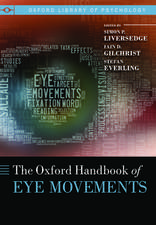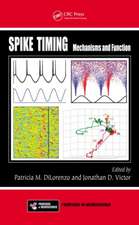Principles of Neural Coding
Editat de Rodrigo Quian Quiroga, Stefano Panzerien Limba Engleză Hardback – 6 mai 2013
- Provides a comprehensive and interdisciplinary approach
- Describes topics of interest to a wide range of researchers
Preț: 1304.91 lei
Preț vechi: 1591.35 lei
-18% Nou
Puncte Express: 1957
Preț estimativ în valută:
249.70€ • 267.01$ • 208.19£
249.70€ • 267.01$ • 208.19£
Carte tipărită la comandă
Livrare economică 18 aprilie-02 mai
Preluare comenzi: 021 569.72.76
Specificații
ISBN-13: 9781439853306
ISBN-10: 1439853304
Pagini: 664
Ilustrații: 179 b/w images, 34 color images, 3 tables and 166
Dimensiuni: 178 x 254 x 41 mm
Greutate: 1.38 kg
Ediția:New.
Editura: CRC Press
Colecția CRC Press
Locul publicării:Boca Raton, United States
ISBN-10: 1439853304
Pagini: 664
Ilustrații: 179 b/w images, 34 color images, 3 tables and 166
Dimensiuni: 178 x 254 x 41 mm
Greutate: 1.38 kg
Ediția:New.
Editura: CRC Press
Colecția CRC Press
Locul publicării:Boca Raton, United States
Public țintă
Academic and Professional Practice & DevelopmentCuprins
Section I Methods. Physiological Foundations of Neural Signals. Biophysics of Extracellular Spikes. Local Field Potentials: Biophysical Origin and Analysis. Spike Sorting. Spike-Train Analysis. Synchronization Measures. Role of Correlations in Population Coding. Decoding and Information Theory in Neuroscience. Section II Experimental Results. Neural Coding of Visual Objects. Coding in the Auditory System. Coding in the Whisker Sensory System. Neural Coding in the Olfactory System. Coding across Sensory Modalities: Integrating the Dynamic Face with the Voice. Population Coding by Place Cells and Grid Cells. Coding of Movement Intentions. Neural Coding of Short-Term Memory. Role of Temporal Spike Patterns in Neural Codes. Adaptation and Sensory Coding. Sparse and Explicit Neural Coding. Information Coding by Cortical Populations. Information Content of Local Field Potentials: Experiments and Models. Principles of Neural Coding from EEG Signals. Gamma-Band Synchronization and Information Transmission. Decoding Information from fMRI Signals. Section III Theoretical and In Silico Approaches. Dynamics of Neural Networks. Learning and Coding in Neural Networks. Ising Models for Inferring Network Structure from Spike Data. Vocal Learning with Inverse Models. Computational Models of Visual Object Recognition. Coding in Neuromorphic VLSI Networks. Open-Source Software for Studying Neural Codes. Index.
Notă biografică
Rodrigo Quian Quiroga is a neuroscientist at the University of Leicester UK. He holds a research chair and is the director of the Centre for Systems Neuroscience and the head of the Bioengineering Research Group at the University of Leicester. In 2010, he obtained the Royal Society Wolfson Research Merit Award. His main research interest is on the study of the principles of visual perception and memory. Together with colleagues at Caltech and UCLA, he discovered what has been named "Concept cells" or "Jennifer Aniston neurons"—neurons in the human brain that play a key role in memory formation.
Stefano Panzeri received a Laurea in Physics from the University of Torino, and a PhD in computational neuroscience from SISSA, Trieste, Italy. He has held personal research fellowship awards in theoretical physics and computational neuroscience, including an INFN Junior Fellowship in Theoretical Physics at Turin University, an EU Marie Curie Postdoctoral Fellowship at the University of Oxford, and an MRC Research Fellowship in Neuroinformatics at the University of Newcastle. He has worked as senior scientist at the Italian Institute of Technology since 2007 and as chair in the Formal Analysis of Cortical Networks at the University of Glasgow since 2012.
Stefano Panzeri received a Laurea in Physics from the University of Torino, and a PhD in computational neuroscience from SISSA, Trieste, Italy. He has held personal research fellowship awards in theoretical physics and computational neuroscience, including an INFN Junior Fellowship in Theoretical Physics at Turin University, an EU Marie Curie Postdoctoral Fellowship at the University of Oxford, and an MRC Research Fellowship in Neuroinformatics at the University of Newcastle. He has worked as senior scientist at the Italian Institute of Technology since 2007 and as chair in the Formal Analysis of Cortical Networks at the University of Glasgow since 2012.
Descriere
Written by renowned experts in the field, this book provides a comprehensive and up-to-date overview of neural coding. It describes the basic principles, covers some of the major developments in the area, and presents a complete view of how neurons in the brain encode information. The text not only contains the most important experimental findings, but also explores the main methodological aspects for studying neural coding. In addition, the book describes alternative approaches based on simulations with neural networks and in silico modeling.













